| 26 July |
• yesterday • tomorrow |
| Memorial of Saints Joachim and Anne, Parents of the Blessed Virgin Mary |
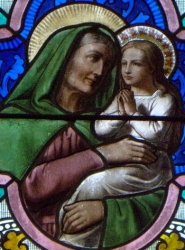
Mother of the Blessed Virgin Mary. Grandmother of Jesus Christ. Wife of Saint Joachim. Probably well off. Tradition says that Anne was quite elderly when Mary was born, and that she was their only child. The belief that Anne remained a virgin in the conception and birth of Mary was condemned by the Vatican in 1677. Believed to have given Mary to the service of the Temple when the girl was three years old. Devotion to her has been popular in the East from the very early days of the Church; widespread devotion in the West began in the 16th century, but many shrines have developed since.
• devotion is Pre-Congregation
• cultus extended to the whole Church in 1584
gracious one; grace
• against poverty
• against sterility or infertility
• broommakers
• cabinetmakers
• carpenters
• childless people
• equestrians
• expectant mothers; pregnant women
• grandmothers
• grandparents
• homemakers
• horse men and women
• housewives; homemakers
• lace makers or workers
• lost articles
• miners
• mothers
• old-clothes dealers
• poor people
• pregnancy
• riders
• seamstresses
• stablemen
• turners
• women in labour
• Canada
• France
• Micmaqs
• 4 dioceses
• 18 cities
• door
• holding Mary or Jesus in her arms or lap
• at her betrothal to Joachim
• teaching Mary to read the Bible
• greeting Saint Joachim at Golden Gate
• woman with a book in her hand
Joachim and Anne, how blessed a couple! All creation is indebted to you. For at your hands the Creator was offered a gift excelling all other gifts: a chaste mother, who alone was worthy of him. Joachim and Anne, how blessed and spotless a couple! You will be known by the fruit you have borne, as the Lord says: "By their fruits you will know them." The conduct of your life pleased God and was worthy of your daughter. For by the chaste and holy life you led together, you have fashioned a jewel of virginity: she who remained a virgin before, during, and after giving birth. She alone for all time would maintain her virginity in mind and soul as well as in body. Joachim and Anne, how chaste a couple! While leading a devout and holy life in your human nature, you gave birth to a daughter nobler than the angels, whose queen she now is. - from a sermon by Bishop Saint John Damascene
Many early Canadian fur traders were Catholic; not only the French-Canadian voyageurs, but their mostly-Scottish employers as well; it's not surprising that they should have had a patron saint. In the memoirs of Alexander Henry (the Elder), written in 1804, he wrote of his first venture into the Canadian fur trade in 1761:
"Saint Anne is the patroness of the Canadians, in all their travels by water."
Henry was a partner in the North West Company, the fur trading company which employed the largest number of voyageurs for the longest time. From the Narrative of Peter Pond, a founding partner of the North West Company, written c.1800, and recounting his experiences in 1773: (My transliteration, from his very idiosyncratic spelling system!).
...This church is dedicated to Saint Anne who protects all voyageurs. Here is a small box with a hole in the top for the reception of a little money for the holy father to say a small mass for those who put a small sum in the box. Scarce a voyageur but stops here and puts in his mite and by that means they suppose that they are protected while absent. The church is not locked but the money box is well secured from thieves. After the ceremony of crossing themselves and repeating a small prayer we crossed the lake...
From the 1793 journal of John Macdonnell, clerk of the North West Company:
At the church of Saint Anns the crews of the canoes collected a voluntary donation amongst themselves to which I contributed my mite, in order to have prayers said for the prosperity of the voyage and a safe return to those engaged in it, to their friends and families.... The next day, we reached Saint Ann's, thirty miles from Montreal. Here we passed the day in repairing the Canoes. I went with others to see the Church and was persuaded to 'promise a Mass' to 'beseech Gods blessing'. I did, and put a shilling in the box of the Roman Church in Montreal, when I returned in 1816 for I had no money then.
This church was at Ste-Anne-de-Bellevue, Quebec, on the west end of Montreal Island, and was the last one that the voyageurs passed before returning from their work in the fur trade, months or years later. The voyageurs had a very hazardous profession; many voyageurs drowned running treacherous rapids in frail birchbark canoes (sometimes entire canoe crews perished). Other times, voyageurs survived the rapids only to starve to death during the winter. My area of study and research ends at 1821, so I don't know much about Saint Anne's role in the fur trade after that. However, Fort Michilimackinac excavated a Saint Anne's medal which was dated to c.1840-1860. - Angela Gottfred Editor, Northwest Journal
https://catholicsaints.info/saint-anne/
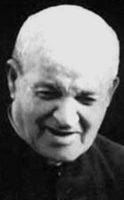
Gorg Preca
Seventh in a Christian family of nine children, the son of Vincent Preco and Nathalie Ceravolo. His father was a merchant and health inspector. George was a sickly child. Studied at the Lyceum and Major Seminary on Malta. A severe respiratory ailment in seminary nearly killed him, but he recovered through the intercession of Saint Joseph. While still a student, he began writing a Rule in Latin for use in a planned society of Permanent Deacons. Ordained 22 December 1906.
After ordination he modified his concept of the society. He began teaching along the waterfront, working with the roughest of men. He gathered a group of young male catechists, including the Servant of God Ewgenju Borg, and they formed the beginning of the Society of Christian Doctrine at Hamrun, Malta in 1907. The Society's motto is represented by the letters M.U.S.E.U.M.: Magister Utinam Sequator Evangelium Universus Mundus! (Master, that the whole world would follow the Gospel!), and were dedicated to bringing the Bible and theology to lay people and the working classes.
Educating the working class was so revolutionary that Father George was accused of insanity, and was once ordered to shut down his operation. He caused more uproar with his plan to educate lay men and women, and send them out to proclaim God's word anywhere that would listen.
Society catechist centers opened in many parishes, teaching young and old, and giving children a place to stay out of trouble. Their teaching brought a deeper understanding of the faith to people who simply went through the motions of devotions, often without knowing why. The bishop of Malta approved the Society and its Rule in 1932.
Father Preca taught and wrote in Maltese, the language of the common people. From leaflets to books, George published approximately 150 works. He had a special devotion to the Mystery of Incarnation. Popular preacher, sought after confessor, and believed to have been a miraculous healer. The Society continues its work today with Centres in Malta, Australia, Sudan, Kenya, Peru, Great Britain, and Albania.
12 February 1880 at Valletta, Malta
• evening of 26 July 1962 of natural causes at Santa Venera, Malta
• relics near the Society's motherhouse at Blata l-Bajda
• 9 May 2001 by Pope John Paul II
• his beatification miracle involved the healing of an irreversibly detached retina of a member of the Society
3 June 2007 by Pope Benedict XVI
Since his death in 1962, shortly before the opening of the Second Vatican Council, Blessed George Preca has been renowned for his holiness both in Malta and wherever the Maltese have settled. Dun Gorg was a pioneer in the field of catechetics and in promoting the role of the laity in the apostolate, which the Council was to stress in a particular way. Thus he became as it were Malta's second father in faith. Embracing meekness and humility, and using to the full his God-given talents of mind and heart, Dun Gorg made his own the words of Paul to Timothy: "You have heard everything that I teach in public; hand it on to reliable people so that they in turn will be able to teach others" (2 Timothy 2: 2). The Society of Christian Doctrine which he founded continues his work of witness and evangelization in these islands and elsewhere.
Not far from here the young seminarian Gorg Preca heard the prophetic words of a priestly mentor: "Gorg, when you grow up many who fear God will gather around you. You will be a blessing for them and they for you". Today the Church in Malta calls Gorg Preca "Blessed", for she knows that he is for her a native source of light and strength. In his writings on meekness - his book L-Iskola tal-Manswetudni and his Letter - Dun Gorg urges his fellow Christians to follow the example of the Crucified Lord in forgiving every offence (cf. Luke 23:34). Is not this message of mutual respect and forgiveness especially needed today in Malta and in the world? Yes indeed, the meekness of the Beatitudes has the power to transform the family, the workplace and schools, the towns and villages, politics and culture. It can change the world! "Blessed are the meek, for they shall inherit the earth" (Matthew 5:5).
Magister, utinam sequatur evangelium universus mundus (Divine Teacher, may the whole world follow the Gospel): the prayer of Blessed Dun Gorg perfectly mirrors the missionary mandate of the Lord: "Go therefore and make disciples....teaching them to observe all that I have commanded you"! (Matthew 28:19-20). During the year of the Great Jubilee the whole Church experienced anew the eternal freshness of the loving mercy of the Father who sent his only Son for our salvation. Was it not Dun Gorg's ability to communicate the freshness of the Christian message that made him the great apostle that he was? Is this not what Malta needs today: clergy, religious, catechists, teachers who passionately proclaim the Good News of what the Father has done for us in Christ? At the dawn of a new millennium, the Church looks to you, Malta, to be still more ardent in living your apostolic and missionary vocation! The whole Church looks to you! - Pope John Paul II during the beatification Mass for Blessed George
https://catholicsaints.info/saint-george-preca/
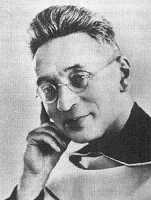
• Anno Sjoera Brandsma
• Shorty
Pious youth from a pious family; three of his four sisters were nuns, and a brother became a Franciscan priest. Had the nickname Shorty. Good student who felt an early call to the priesthood. Entered a Franciscan minor seminary from ages 11 to 17, but health problems, primarily an intestinal disorder, prevented him becoming a Franciscan. Joined the Carmelites at Boxmeer, Netherlands, taking the name Titus, and making his first vows in 1899.
Spoke Italian, Frisian, Dutch, and English, and could read Spanish. Translated the works of Saint Teresa of Avila from Spanish to Dutch, publishing them in 1901. Ordained in 1905 at age 24. Doctorate in philosophy from the Pontifical Gregorian University in Rome, Italy in 1909 at age 28. Taught at the Carmelite seminary at Oss, Netherlands. Editor of the local daily newspaper in 1919; often seen working with a cigar in his mouth.
Taught philosophy at Catholic University, Nijmegen, Netherlands. Superior of the university's Carmelite student house. Popular confessor. Widely travelled orator, journalist, author, and lobbyist for the university. University president in 1932. Appointed ecclesiastical advisor to Catholic journalists in 1935. Conducted a speaking tour throughout the United States beginning in 1935.
In 1935 he wrote against anti-Jewish marriage laws, which brought him to the attention of the Nazis. He later wrote that no Catholic publication could publish Nazi propaganda and still call itself Catholic; this led to more attention. Continually followed by the Gestapo, the Nazi attention led to his arrest on 19 January 1942. For several weeks he was shuttled from jail to jail, abused, and punished for ministering to other prisoners.
Deported to the Dachau concentration camp in April 1942. There he was overworked, underfed, and beaten daily; he asked fellow prisoners to pray for the salvation of the guards. When he could no longer work, he was used for medical experiments. When he was no longer any use for experimentation, he was murdered. Martyr.
23 February 1881 at Oegeklooster, Friesland, Netherlands as Anno Sjoera Brandsma
• martyred on 26 July 1942 by lethal injection in the concentration camp at Dachau, Bavaria, Germany
• his executioner was a nurse who had been raised Catholic, but left the Church
• body cremated, and no relics remain
3 November 1985 by Pope John Paul II
• Prayer Before a Picture of Jesus
• Spirituality of the Carmelites of the Ancient Observance
• Letter from Dachau Prison, 12 July 1942
Not my will but yours be done! - what Blessed Titus would shout during torture and medical experiments
https://catholicsaints.info/blessed-titus-brandsma/
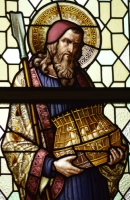
Heli
Husband of Saint Anne, elderly father of the Blessed Virgin Mary. Grandfather of Jesus Christ. Probably well off. Tradition says that while he was away from home, he and Anne each received a message from an angel that she was pregnant. Believed to have given Mary to the service of the Temple when the girl was three years old.
Joachim is mentioned in neither historical nor canonical writings. The information we have on Joachim derives mainly from the apocryphal Protoevangelium of James.
Galilean
the traditional tomb of Saint Anne and Saint Joachim was rediscovered in Jerusalem in 1889
• Adjuntas, Puerto Rico
• fathers
• grandfathers
• grandparents
• man bringing a lamb to the altar and being turned away by the priest
• greeting and/or kissing Saint Anne at the Golden Gate
• elderly man carrying a basket of doves and a staff
• elderly man with the child Mary
Joachim and Anne, how blessed a couple! All creation is indebted to you. For at your hands the Creator was offered a gift excelling all other gifts: a chaste mother, who alone was worthy of him. Joachim and Anne, how blessed and spotless a couple! You will be known by the fruit you have borne, as the Lord says: "By their fruits you will know them." The conduct of your life pleased God and was worthy of your daughter. For by the chaste and holy life you led together, you have fashioned a jewel of virginity: she who remained a virgin before, during, and after giving birth. She along for all time would maintain her virginity in mind and soul as well as in body. Joachim and Anne, how chaste a couple! While leading a devout and holy life in your human nature, you gave birth to a daughter nobler than the angels, whose queen she now is. - from a sermon by Bishop Saint John Damascene
https://catholicsaints.info/saint-joachim/
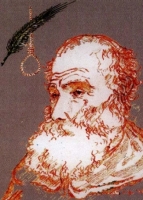
• Robert Askew
• Robert Rowley
• 22 November as one of the Martyrs of England, Scotland, and Wales
• 29 October as one of the Martyrs of Douai
• 1 December as one of the Martyrs of Oxford University
Brother of Blessed John Nutter. Educated at Brasenose College, Oxford, England in the mid-1560's. Seminarian at the English College, Rheims, France. Ordained at Soissons, France on 21 December 1581. Returned to England with Blessed George Haydock to minister to covert Catholics. He worked for two years, was imprisoned and tortured in the Tower of London for two years, and then exiled for the crime of being a priest. After a few months in France to recover, he returned to England; he was arrested almost immediately and spent nearly 15 years in prison. He joined the Dominicans in prison, received into the order by the Provincial of Portugal. He managed to escape in March 1600, was re-captured in May, lodged in Wisbich Castle, tortured, and finally hanged with Blessed Edward Thwing.
c.1557 at Burnley Lanes, Lancashire, England
hanged on 26 July 1600 at Lancaster, England
22 November 1987 by Pope John Paul II
Almighty, ever-living God,you gave your martyrs Robert Nutter and his companions grace to lay down their lives for Christ. Help our weakness too: give us the strength to live for you, even as they did not shrink from dying for your sake. We ask this through our Lord Jesus Christ, your Son, who lives and reigns with you and the Holy Spirit, one God, for ever and ever. - Dominicans
https://catholicsaints.info/blessed-robert-nutter/
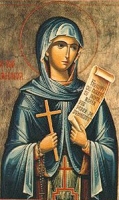
Daughter of the wealthy Christians Politea and Agathon, and was born after much praying by them for a child. Unusually well educated for a girl of her time. When her parents died, she gave her property to the poor and became an persuasive, itinerant preacher. During a time of persecutions by Roman and Jewish officials, she brought many to Christianity.
Arrested for her faith and her success in the persecutions of Antoninus Pius. She was tortured to make her renounce her faith; she declined. Thrown into a vat of boiling oil, she stood in it unharmed. The emperor asked if she had cooled the oil by magic; she scooped up a handful and threw it in his eyes, burning and blinding him. The emperor screamed for mercy; Parasceva called out the named of Jesus, and the emperor was instantly healed. This miracle moved Antoninus to end the persecution of Christians until his death in 161.
Parasceva resumed her preaching, and upon Antoninus' death, imperial Rome under Marcus Aurelius resumed persecution of the Christians. The Roman governor Asclepius threw her into a pit with a poisonous snake; she make the sign of the cross over the creature, it split in two like it was cut with a sword, and she converted Asclepius and many of his court. Dragged before the governor Tarasios, she began to preach. She was tortured to make her deny God; she replied to each question or order with the word Christ. Her tormentors finally gave up, and she was martyred.
• beheaded in 180
• relics taken to Constantinople
blind people
https://catholicsaints.info/saint-parasceva-of-rome/
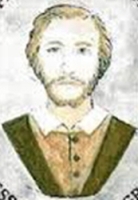
• 29 October as one of the Martyrs of Douai
• 1 December as one of the Martyrs of Oxford University
Son of Anthony Ingram of Wolford, Warwickshire, and Dorothy, daughter of Sir John Hungerford. Educated at Worcestershire and the New College, Oxford, England. Adult convert to Catholicism. Continued his education at the English College, Rheims, France; the Jesuit College, Pont-a-Mousson, France; and the English College, Rome, France. Ordained at Rome in 1589.
Missioner to Scotland in early 1592 supported by Lords Huntly, Angus, and Erroll, the Abbot of Dumbries, and Sir Walter Lindsay of Balgavies. Arrested on the Tyne River for his faith on 25 November 1593. Imprisoned at Berwick, Durgam, York, and the Tower of London. Tortured in the Tower for the names of other "traitorous" Catholics, he gave away nothing, ministered to and encouraged his fellow prisoners, and still wrote 20 Latin epigrams that have survived.
Relayed north again through prisons at York, Newcastle, and Durgan. Convicted, with Saint John Boste and Saint George Swallowell (the other two Durham Martyrs), for the high crime of priesthood. Some one in Scotland offered the English government 1,000 crowns as ransom for his life, but it was declined, and he was executed.
1565 at Stoke Edith, Herefordshire, England
hanged, drawn, and quartered on 26 July 1594 at Newcastle-on-Tyne near Durham, England
15 December 1929 by Pope Pius XI
https://catholicsaints.info/blessed-john-ingram/
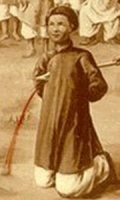
• Andrew of Phuù Yeân
• Anrê of Phú Yên
Son of a devoutly Christian mother, Anrê was baptized at age 15 by Jesuit missionary Father Alexandre de Rhodes. Andrew became a catechist a year later. In 1643, with other catechists, he made a vow to serve the Church for the rest of his life. In 1644 he was arrested and beaten, the king having ordered a halt to Christianity and forbidding natives to join the religion. Andrew was offered a release by Mandarin Ong Nghe Bo if he would renounce the faith; he declined. Condemned on 26 July 1644, and executed the next day. Andrew was the first Vietnamese martyr.
Father de Rhodes retrieved the body and shipped it to Macao for burial. When the transport ship was attacked by pirates, it struck a rock, and a hole was torn in the hull. A large stone rolled into the gap, held out the water, and the ship was able to deliver its cargo.
1625 at Ran Ran, Phú Yên (in modern Viet Nam)
• hanged 26 July 1644 at Kè Khàm, Quang Nam (in modern Viet Nam)
• buried in Macao
5 March 2000 by Pope John Paul II
https://catholicsaints.info/blessed-andrew-the-catechist/
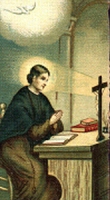
18 May (Sisters of Maria Bambina; Diocese of Brescia, Italy; Diocese of Bergamo, Italy; Archdiocese of Milan, Italy)
Daughter of an alcoholic corn-factor. Wanted to become a nun, but her family opposed the decision, and so she took a private vow of perpetual chastity, and began teaching and working with youth as a lay woman. Extensive correspondent, often writing on spirituality; many of letters were later collected and published.
With Saint Vincentia Gerosa, she founded the Sisters of Charity of Lovere in 1832. Based on the Rule of the Sisters of Charity of Saint Vincent de Paul, it was dedicated to teaching the young, and caring for the impoverished sick. The congregation received papal approval in 1840, and today has over 500 communities.
13 January 1807 at Lovere, Bergamo, Italy
26 July 1833 at Lovere, Bergamo, Italy of tuberculosis
18 May 1950 by Pope Pius XII
https://catholicsaints.info/saint-bartholomea-capitanio/
William Webster
29 October as one of the Martyrs of Douai
Raised Protestant. Teacher. Travelled to Spain with a Catholic friend, and there joined the Church. Back home, he converted his mother. Repeatedly imprisoned for professing his faith. At 40 he went to Belgium to study for the priesthood. Ordained. Took the name Father William Ward. Travelled to Scotland where he was immediately thrown into prison for three years. He worked the next 30 years in and around London, secretly ministering to the Catholic population and the poor in general. Frequently jailed or banished. Eventually betrayed by a priest-hunter and thrown into Newgate Prison. Martyred, uttering the words: "Jesus, Jesus, Jesus, receive my soul!"
c.1560 in England as William Webster
hanged, drawn, and quartered on 26 July 1641 at Tyburn, London, England
15 December 1929 by Pope Pius XI
https://catholicsaints.info/blessed-william-ward/
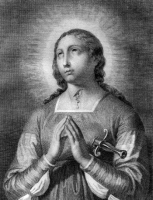
Born to the Italian nobility. Friend and supporter of the future Pope Benedict XIV. Suffered through an arranged marriage to the violent, abusive and anti-religious Baptiste Santucci who hated her family for their Catholicism, and in 1482 killed Pierozzo Grassi for being a pious Christian. Camilla intervened on her hubsand's behalf and saved him from punishment, but he later turned on her, killing her defying him, for visiting her mother, and for remaining a pious Catholic. Martyr.
latter 15th century in San Severino Marche, Italy
• stabbed in the throat and heart on 26 July 1486 on a farm in Uvaiolo, San Severino Marche, Italy
• buried in the family plot at the church of Santa Maria del Mercato (modern church of San Domenico)
15 January 1841 by Pope Gregory XVI
https://catholicsaints.info/blessed-camilla-gentili/
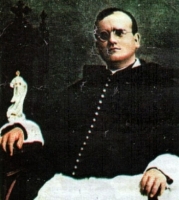
Ordained in the diocese of Granada, Spain in 1915. Received a doctorate in theology. Teacher and chaplain at the seminary of Granada, Spain. Parish priest at the Divine Shepherdess church in Motril, Spain where he lived in poverty to help support the local poor, and worked endlessly for his parishioners. During the persecutions he sheltered the Daughters of Charity in his church. Found by anti-Christian forces, he was ordered to blaspheme to show his renunciation of the faith; he refused. Martyr.
2 October 1892 in Churriana de la Vega, Granada, Spain
shot on 26 July 1936 in the atrium of the Divine Shepherdess parish church in Motril, Granada, Spain
7 March 1999 by Pope John Paul II
https://catholicsaints.info/blessed-manuel-martin-sierra/
• 22 November as one of the Martyrs of England, Scotland, and Wales
• 29 October as one of the Martyrs of Douai
Second son of Thomas and Jane Thwing. Studied at the English College in Rheims, France, with the Jesuits at Pont-à-Mousson, France, and then in Rome, Italy. Taught rhetoric and logic in Rheims. Ordained in Laon, France in December 1588. Returned to England in 1597 to serve covert Catholics during a period of government persecution. Arrested for the crime of being a priest, he was imprisoned with Blessed Robert Nutter. The two escaped but were re-arrested in May 1600 and executed together a few weeks later. Martyr.
Heworth, England
hanged on 26 July 1600 at Lancaster, England
22 November 1987 by Pope John Paul II
https://catholicsaints.info/blessed-edward-thwing/
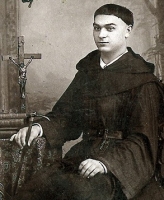
Vicente of Saint Aloysius Gonzaga
Priest. Member of the Augustinian Recollects. Missionary to the Philippines. When anti-Christian persecutions began in the islands, he was transferred to Brazil, and later to Motril, Spain. Had a devotion to Our Lady of Consolation, was dedicated to hearing confessions, and loved working with children. Martryred in the Spanish Civil War.
9 April 1870 in Calatayud, Zaragoza, Spain
shot on 26 July 1936 in the atrium of the Divine Shepherdess parish church in Motril, Granada, Spain
7 March 1999 by Pope John Paul II
https://catholicsaints.info/blessed-vicente-pinilla-ibanez/
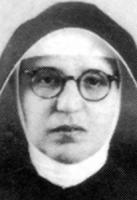
• Maria Pierina De Micheli
• Sister Maria Pierina
Nun in the Congregation of the Daughters of the Immaculate Conception. She received a number of visions that led her to promote devotion to the Holy Face of Jesus.
11 September 1890 in Milan, Italy
26 July 1945 in Centonara d'Artò, Verbano-Cusio-Ossola, Italy of natural causes
• 30 May 2010 by Pope Benedict XVI
• recognition celebrated in the Basilica of Saint Mary Major, Rome, Italy, celebrated by Archbishop Angelo Amato
https://catholicsaints.info/blessed-giuseppina-maria-de-micheli/
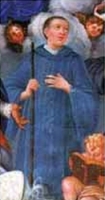
• Hugh of Actes
• Hugh of Atti
• Hugues, Hugo, Ugo
Studied at Bologna, Italy. Spiritual student of Saint Silvester Guzzolini. Benedictine monk.
c.1227 at Serra San Quirico, diocese of Camerino, Italy
26 July 1250 at Sassoferrato, Italy of natural causes
27 July 1757 by Pope Benedict XIV (cultus confirmed)
Sassoferrato, Italy
https://catholicsaints.info/blessed-hugh-of-sassoferrato/
Priest in the diocese of Bourges, France. Imprisoned on a ship in the harbor of Rochefort, France and left to die during the anti-Catholic persecutions of the French Revolution. One of the Martyrs of the Hulks of Rochefort.
28 June 1752 in Saint-Sauvier, Allier, France
26 July 1794 aboard the prison ship Deux-Associés, in Rochefort, Charente-Maritime, France
1 October 1995 by Pope John Paul II
https://catholicsaints.info/blessed-pierre-joseph-le-groing-de-la-romagere/
Priest in the diocese of Bourges, France. Imprisoned on a ship in the harbor of Rochefort, France and left to die during the anti-Catholic persecutions of the French Revolution. One of the Martyrs of the Hulks of Rochefort.
3 November 1751 in Limoges, Haute-Vienne, France
26 July 1794 aboard the prison ship Deux-Associés, in Rochefort, Charente-Maritime, France
1 October 1995 by Pope John Paul II
https://catholicsaints.info/blessed-marcel-gaucher-labiche-de-reignefort/
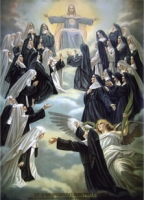
Sister Catherine of Jesus
9 July as one of the Martyrs of Orange
Ursuline nun. Martyred in the French Revolution.
6 September 1724 in Bollène, Vaucluse, France
guillotined on 26 July 1794 in Orange, Vaucluse, France
10 May 1925 by Pope Pius XI
https://catholicsaints.info/blessed-marie-madeleine-justamond/
Ostent, Austinde
Benedictine monk at Saint Oren’s Abbey, Auch, France. Abbot. Instituted the Cluniac reform at Saint Oren’s. Archbishop of Auch in 1041. Helped restore Christian life in his and his suffragan dioceses following the Saracen invasion of Spain. Had to struggle with princes and civil authorities to keep Church rights, prerogatives and property.
c.1000 in Bordeaux, France
1068 at Auch, Aquitaine (in modern France) of natural causes
https://catholicsaints.info/saint-austindus-of-auch/
Treasurer of the city of Corinth, Greece. Convert, brought to the faith by Saint Paul the Apostle. Assisted Paul, especially around Corinth. Bishop of Philippi, Macedonia. Martyr.
Erastus, the city treasurer, and our brother Quartus greet you. - Romans 16:23
Then he sent to Macedonia two of his assistants, Timothy and Erastus, while he himself stayed for a while in the province of Asia. - Acts 19:22
Erastus remained in Corinth, while I left Trophimus sick at Miletus. - 2nd Timothy 4:20
https://catholicsaints.info/saint-erastus/

Sister Saint Augustine
9 July as one of the Martyrs of Orange
Sacramentine nun. Martyred in the French Revolution.
18 June 1719 in Sérignan, Vaucluse, France
guillotined on 26 July 1794 in Orange, Vaucluse, France
10 May 1925 by Pope Pius XI
https://catholicsaints.info/blessed-marie-marguerite-bonnet/

9 July as one of the Martyrs of Orange
Ursuline nun. Martyred in the French Revolution.
9 June 1736 in Courthezon, Vaucluse, France
guillotined on 26 July 1794 in Orange, Vaucluse, France
10 May 1925 by Pope Pius XI
https://catholicsaints.info/blessed-elisabeth-therese-de-consolin/

Sister Claire of Saint Rosalie
9 July as one of the Martyrs of Orange
Ursuline nun. Martyred in the French Revolution.
9 January 1727 in Laudun, Gard, France
guillotined on 26 July 1794 in Orange, Vaucluse, France
10 May 1925 by Pope Pius XI
https://catholicsaints.info/blessed-marie-claire-du-bac/
Born to a Russian father and an Aleut mother. Studied at the seminary in Irkutsk, Russia. Priest. Missionary to the indigenous people on the Aleutian Islands, travelling by kayak and dogsled; he often had to deal with the opposition of native shamans. Translated the New Testament into the Youpik language.
Alaska
1865
https://catholicsaints.info/blessed-jacques-netsetov/
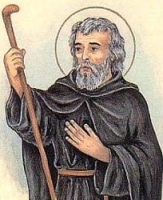
Bénigne
Augustinian hermit in the Malcesine area on the shore of Lake Garda near Verona, Italy c.800. Known for his piety, deep prayer life and wisdom, he was a much sought spiritual director.
https://catholicsaints.info/saint-benigno-of-malcestine/
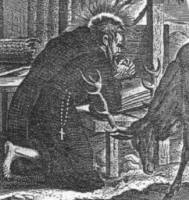
Hermit. Pilgrim to Jerusalem, to Rome, Italy, to Compostella, Spain, and to Tours, France. Miracle worker. Monk at Padolirone Abbey near Padua, Italy.
Armenia
1016
https://catholicsaints.info/saint-simeon-of-padolirone/
Evangelist
13th century Augustinian hermit in the area of Verona, Italy. Priest.
Verona, Italy
1250 of natural causes
1837 by Pope Gregory XVI (cultus confirmation)
https://catholicsaints.info/blessed-evangeliste-of-verona/
Peregrine
13th century Augustinian hermit in the area of Verona, Italy. Priest.
Verona, Italy
1250 of natural causes
1837 by Pope Gregory XVI (cultus confirmation)
https://catholicsaints.info/blessed-peregrin-of-verona/
Layman schoolmaster and Protestant minister. Convert to Catholicism, which led to his execution. Martyr.
Shadforth, Durham, England
26 July 1594 at Darlington, England
15 December 1929 by Pope Pius XI
https://catholicsaints.info/blessed-george-swallowell/
Slave in imperial Rome. Helped bring Saint Olympius the Tribune, Saint Exuperia the Martyr and Saint Theodulus the Martyr to the faith. Martyred in the persecutions of Valerian.
burned to death in 257
https://catholicsaints.info/saint-symphronius-the-slave/
Married to Saint Exuperia the Martyr; father of Saint Theodulus the Martyr. Convert, brought to the faith by Saint Symphronius the Slave. Martyred in the persecutions of Valerian.
burned to death in 257
https://catholicsaints.info/saint-olympius-the-tribune/
Married to Saint Olympius the Tribune; mother of Saint Theodulus the Martyr. Convert, brought to the faith by Saint Symphronius the Slave. Martyred in the persecutions of Valerian.
burned to death in 257
https://catholicsaints.info/saint-exuperia-the-martyr/
Caro
Augustinian hermit in the Malcesine area on the shore of Lake Garda near Verona, Italy c.800. Known for his piety, deep prayer life and wisdom, he was a much sought spiritual director.
https://catholicsaints.info/saint-charus-of-malcestine/
Son of Saint Olympius the Tribune and Saint Exuperia the Martyr. Convert, brought to the faith by Saint Symphronius the Slave. Martyred in the persecutions of Valerian.
burned to death in 257
https://catholicsaints.info/saint-theodulus-the-martyr/
Bishop in Armenia. Died while on pilgrimage.
Armenian
1033 at Bethune, Artois, France
https://catholicsaints.info/blessed-joris/
Monk in Melk, Austria.
• 1020 of natural causes
• miracles reported at their tomb
https://catholicsaints.info/saint-gothalm/
Brother of Pope Pius I. Priest in Rome, Italy.
c.160
https://catholicsaints.info/saint-pastor-of-rome/
Martyred in the persecutions of Trajan.
c.110
https://catholicsaints.info/saint-hyacinth-26-july/
Bishop of Verona, Italy in 524.
531
https://catholicsaints.info/saint-valens-of-verona/
Desert mountain hermit near the monastery of Saint Panteleimon.
https://catholicsaints.info/saint-gerontios/
Thousands of people were murdered in the anti-Catholic persecutions of the Spanish Civil War from 1934 to 1939. I have pages on each of them, but in most cases I have only found very minimal information. They are available on the CatholicSaints.Info site through these links:
• Blessed Aleix Miquel Rossell
• Blessed Amadeu Amalrich Rasclosa
• Blessed Amadeu Costa Prat
• Blessed Amancio Marín Mínguez
• Blessed Antoni Jaume Secases
• Blessed Antonio Cerdá Cantavella
• Blessed Francesc Vidal Sanuy
• Blessed Gumersindo Valtierra Alonso
• Blessed José Elcano Liberal
• Blessed Josep Casademont Vila
• Blessed Josep Maria Jordá i Jordá
• Blessed Josep Masquef Ferré
• Blessed Lluís Plana Rabugent
• Blessed Manuel Jové Bonet
• Blessed Manuel Martín Sierra
• Blessed Miguel Oscoz Arteta
• Blessed Miquel Vilatimó Costa
• Blessed Onésimo Agorreta Zabaleta
• Blessed Pau Gili Pedrós
• Blessed Pau Roselló Borgueres
• Blessed Pere Caball Juncà
• Blessed Santiago Altolaguirre y Altolaguirre
• Blessed Senén López Cots
• Blessed Teófilo Casajús Alduán
• Blessed Vicente Pinilla Ibáñez
• Blessed Vicente Vázquez Santos
• Blessed Xavier Amargant Boada
• Blessed Xavier Sorribas Dot
• Christiana of Termonde
• Claudia of France
• Erasto of the Philippines
• Frederick Zelecky
• Ivo Belhuec
• Juan Iraizos
• Mariano di San Giuseppe
• Moses of Hungary
• Pierre Dallemand
• Sancha of Leon
• Sabas III of Serbia
• Seve
• Ursus of Troyes
CatholicSaints.Info Portable Edition